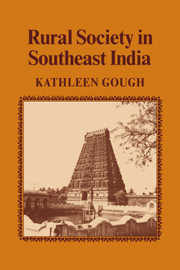Book contents
- Frontmatter
- Contents
- Preface
- Part I Thanjāvūr
- Part II Kumbapeṭṭai
- 8 The Face of the Village
- 9 Kumbapeṭṭai before 1855
- 10 Kumbapeṭṭai from 1855 to 1952
- 11 The Annual Round
- 12 Economics and Class Structure: The Petty Bourgeoisie
- 13 Independent Commodity Producers and Traders
- 14 The Semiproletariat
- 15 Village Politics: Religion, Caste, and Class
- 16 Village Politics: The Street Assembly
- 17 Class Struggle and Village Power Structure
- Part III Kirippūr
- Notes
- Glossary
- Bibliography
- Index
- CAMBRIDGE STUDIES IN SOCIAL ANTHROPOLOGY
15 - Village Politics: Religion, Caste, and Class
from Part II - Kumbapeṭṭai
Published online by Cambridge University Press: 29 October 2009
- Frontmatter
- Contents
- Preface
- Part I Thanjāvūr
- Part II Kumbapeṭṭai
- 8 The Face of the Village
- 9 Kumbapeṭṭai before 1855
- 10 Kumbapeṭṭai from 1855 to 1952
- 11 The Annual Round
- 12 Economics and Class Structure: The Petty Bourgeoisie
- 13 Independent Commodity Producers and Traders
- 14 The Semiproletariat
- 15 Village Politics: Religion, Caste, and Class
- 16 Village Politics: The Street Assembly
- 17 Class Struggle and Village Power Structure
- Part III Kirippūr
- Notes
- Glossary
- Bibliography
- Index
- CAMBRIDGE STUDIES IN SOCIAL ANTHROPOLOGY
Summary
By “politics” I shall refer to the distribution of power and authority within groups larger than the family.
We have seen that members of the petty bourgeoisie were able to maintain their standard of living and pay their taxes only by severely exploiting the semiproletariat and, to a lesser extent, the middle peasants. The main political problems of the petty bourgeoisie were, therefore, how to maintain order among themselves and how to prevent or suppress rebellion by the lower classes. Those of the middle peasants and the semiproletariat were how to maintain order among themselves and how to carry on the struggle for survival, or, if possible, for betterment of their conditions.
The landlords' chief sources of control were religious beliefs and activities. As late as 1952, the religious moment dominated the political and economic moments in village social life. It is therefore necessary to refer to the religious system as it affected the political structure, although a full analysis of religious institutions cannot be undertaken here.
In Brahmanical thought, the whole social order was divinely ordained and sanctioned, its component units being seen as castes and groups of castes. As is well known, the four varnas were symbolically represented as issuing from the head, arms, thighs, and feet of the creator. The castes were seen as proliferating from the varnas, each divinely required to carry out its dharma, or caste duty.
- Type
- Chapter
- Information
- Rural Society in Southeast India , pp. 289 - 303Publisher: Cambridge University PressPrint publication year: 1982

